Pittura Metafisica
Pittura Metafisica (Ital. for "metaphysic painting") denotes a style that came up in Italy as early as in 1911/12, lasting up into the 1920s. The term originates from the main master and founding father of Pittura Metafisica, Giorgio de Chirico (1888-1978). Artists such as Carlo Carrà (1881-1966) and Giorgio Morandi (1890-1964) followed his example around 1917/18.
A fundamental feature of the Pittura Metafisica, in its literal sense, is the depiction of the object's "super-natural" features (Greek "metá" = beyond; "phýsis" = nature), the object's content beyond its visible features. These ideas had clearly been influenced by Giorgio de Chirico's younger brother Andrea, who was working as a writer and painter under the pseudonym Alberto Savinio. Philosophical concepts of Friedrich Nietzsche and Arthur Schopenhauer also occupied fundamental roles in this context.
A fundamental feature of the Pittura Metafisica, in its literal sense, is the depiction of the object's "super-natural" features (Greek "metá" = beyond; "phýsis" = nature), the object's content beyond its visible features. These ideas had clearly been influenced by Giorgio de Chirico's younger brother Andrea, who was working as a writer and painter under the pseudonym Alberto Savinio. Philosophical concepts of Friedrich Nietzsche and Arthur Schopenhauer also occupied fundamental roles in this context.
The painters of the Pittura Metafisica created coulisse-like and perspectively exaggerated views that seemed like dreams filled with over-sharply modeled figures and objects, which have been taken from their original contexts and rearranged in new and strange relations. Man is also treated as an object - as "manichino", a faceless jointed doll, or as a construct of stereometric basic forms. Isolation, alienation, inexplicability and mysteriousness coin the atmosphere of the calm, motionless Pittura Metafisica that wanted to be less a way of painting than a means of observing.
In their concept of materiality, but also in terms of style, the artists of the Pittura Metafisica referred to the solemn and strict austerity of the Early Renaissance (Giotto, Masaccio, Piero della Francesca, Paolo Uccello). The simultaneosuly upcoming dynamic Futurism can be perceived as a counter movement to the Pittura Metafisica - Carlo Carrà, up until 1915 one of the leading artists of Futurism, explained his turn to the Pittura Metafisica with the rediscovery of the "principio italiano", which was prevailing in Renaissance.
The Pittura Metafisica had effects beyond the borders of Italy, especially on New Oobjectivity and Surrealism, which both came up up a little later.
De stijl
After World War I there was a turning away from old forms and philosophies among architects and designers, just as there was among artists and writers. Many of the same abstract ideas came into play, as did ideas that incorporated the "machine" aesthetics of the new industrial age. In fact, one of the important trends of the 20th century would be the increasing parallels between - even merging of - art and design, which had been separated since the end of the renaissance.
In the early 1920's a group of architects and artists, influenced by some of the ideas of DaDa, formed a movement called de Stijl (Dutch for The Style). Theirs was a utopian philosophical approach to aesthetics, centered in a publication called de Stijl, which presented their ideas and designs. The founder of the publication and leader of the group was Theo van Doesburg, an architect. Other important participants were Gerrit Rietveld and Piet Mondrian.
The philosophy was based on functionalism, with a severe and doctrinaire insistence on the rectilinearity of the planes, which seem to slide across one another like sliding panels. All surface decoration except color was to be eliminated, and only pure primary hues, plus black and white were to be allowed.
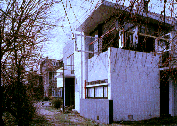 The most important thing about this group was their ideas, since they managed to build very few of their designs. One important exception is Gerrit Rietveld's Schroeder House, which is the most complete realization of the de Stijl aesthetic. Not only the house, but also the furnishings and decoration were planned by Rietveld. In spite of the apparently small output of this group, they would be very influential on subsequent design styles.
The most important thing about this group was their ideas, since they managed to build very few of their designs. One important exception is Gerrit Rietveld's Schroeder House, which is the most complete realization of the de Stijl aesthetic. Not only the house, but also the furnishings and decoration were planned by Rietveld. In spite of the apparently small output of this group, they would be very influential on subsequent design styles.The initial source of their ideas came from DaDa notions about dispensing with the pretentious elitist design aesthetics of the pre war era. Some of the early work of Frank Lloyd Wright, which had been published in Europe in 1910, influenced their notions about form. Japanese sources were also of significance, though these ideas may have been derived through the work of Wright.
Bauhaus and the "International Modern" Style
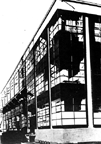 The Bauhaus school was established in 1919 in Dessau, Germany by a group of architects, engineers, and artists led by Walter Gropius. The ideals of this group were social and political as well as aesthetic. They sought solutions for the problems faced by the working classes in the depression years of Post World War I Germany. Their concerns included urban planning, housing, and the development of high-quality, utilitarian mass production of consumer goods.
The Bauhaus school was established in 1919 in Dessau, Germany by a group of architects, engineers, and artists led by Walter Gropius. The ideals of this group were social and political as well as aesthetic. They sought solutions for the problems faced by the working classes in the depression years of Post World War I Germany. Their concerns included urban planning, housing, and the development of high-quality, utilitarian mass production of consumer goods.A unique feature of their program was the melding of handicraft and industrial production methods. Crafts were thought to be the necessary first step in the training of engineers, architects and industrial designers. In this they differed from the theoreticians of the Arts and Crafts movement, who resisted the use of industrial methods and materials; yet the Bauhaus designers shared the Arts and Crafts veneration of the hand crafts. All engineering and design students took craft courses as well as painting, drawing, and theoretical studies in design and color.
The design style of the Bauhaus group owed a great deal to the de Stijl group, some of whom joined the school as teachers. The ideal of form following function was also emphasized, emphasizing the honest and direct use of materials as the most "functional" way to design. The result was spare, rectilinear forms-- in architecture, for example, the structural components of steel, glass, concrete, and other industrial materials were to be used directly and honestly, without imitative form.
The Bauhaus style and teaching methods would become very influential in the teaching of design throughout Europe and the United States, since the teachers emigrated to other universities and design schools in other countries when the Bauhaus was closed by Hitler in 1933. This link will take you to a selection of works by Bauhaus artists and designers. By the outbreak of World War II most were in the United States teaching in major institutions, where they would influence a whole generation of artists and designers. To this day, Bauhaus methods strongly influence the teaching of design in many schools, as can be seen by this directory of Bauhaus-related learning resources.
Among the most important figures in the Bauhaus school are the architects
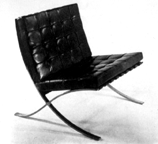 Walter Gropius , designer of the Pan Am Building in New York; Mies van der Rohe, who designed the modernist classic, the Barcelona chair, and a number of important buildings as well. Among the artists associated with the Bauhaus are Wassily Kandinsky, Paul Klee, Joseph Albers, and Johannes Itten, all of whom published and taught their philosophies of art and design.
Walter Gropius , designer of the Pan Am Building in New York; Mies van der Rohe, who designed the modernist classic, the Barcelona chair, and a number of important buildings as well. Among the artists associated with the Bauhaus are Wassily Kandinsky, Paul Klee, Joseph Albers, and Johannes Itten, all of whom published and taught their philosophies of art and design.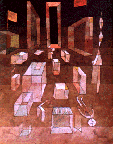 Following World War II the style broadened into what became known as the international modern style . The pure form and honest use of materials continued to define architecture and interior design following World War II. However, some designers began to explore the broader structural design potential of industrial materials, and broke with the strict rectilinear forms of the pre-war era.
Following World War II the style broadened into what became known as the international modern style . The pure form and honest use of materials continued to define architecture and interior design following World War II. However, some designers began to explore the broader structural design potential of industrial materials, and broke with the strict rectilinear forms of the pre-war era. Among the architects associated with the international style are Le Corbusier, Eero Saarinen, and Marcel Breuer.
Among the architects associated with the international style are Le Corbusier, Eero Saarinen, and Marcel Breuer.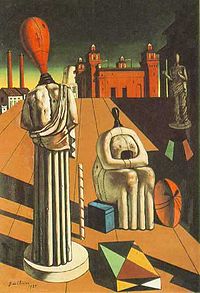
No comments:
Post a Comment